
In 1962, I joined Remington Arms Company, as a trainee, in its Shooting Promotion Department; a part of Remington’s sales and marketing division. I was soon to learn all about the manufactured products, including firearms and ammunition, and all related goods. I eventually become a member of the highly respected Remington sales force. In 1962, Remington was producing three different autoloading shotguns. These were the gas-operated Sportsman ’58 (introduced in 1956), the Model 878 (introduced 1959) and the Model 11-48 (introduced in 1948, and which had a recoil operating systems similar to the venerable Browning designed Model 11). The Sportsman ’58 and the Model 878 were gas-operated and had a piston, that was inside the magazine tube, that was forced to the rear by the gasses from the burning powder, which made it more difficult to keep clean.
Years of research and development by Wayne Leek’s Firearms Research Program team (also consisting of James Martin, Charles Morse, Clark Workman and R. P. Kelly) would soon produce in a new autoloader which combined the best features of all three, including appearance, balance, low recoil, durability and dependability under all field and target conditions.
Never having had a shotgun to my shoulder before, I went out to Remington’s gun club, located in Stratford. Connecticut. The Lordship Gun Club had been around since the 1920s and, at that time, was open to the public. A great place to learn to shoot skeet and trap. If one didn’t know how to shoot,
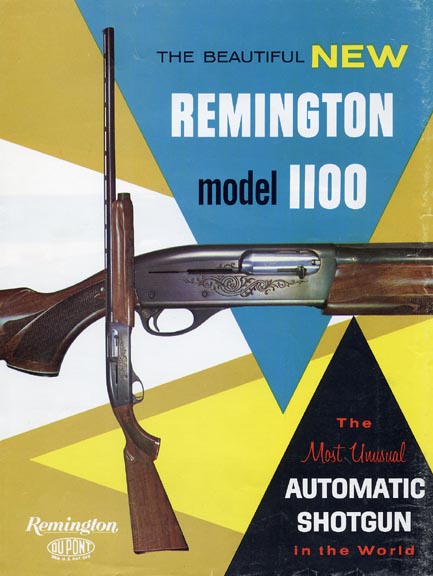
|
excellent instructors were available for the asking. I started with skeet, using a Remington Model 878, with earplugs and shooting glasses. Needless to say, I soon became an avid skeet and trap shooter.
In December 1962, at Remington’s National Sales Meeting, with salesmen from all over the country, we learned about a new shotgun that was said to reduce recoil up to 55%. Wow! The newly introduced Model 1100 autoloader was born. I soon switch my allegiance from the Model 878 to the new Model 1100 and started shooting even more trap at Lordship. The Model 1100 was officially introduced to the trade, in January 1963, in 12 gauge 2″ standard and 3″ magnum shotshells. |
In the spring of 1963, the manager of Shooting Promotion, Curt Clair, recruited Dick Baldwin, Earl Larson. myself, and a few others to participate in the filming of the clay target shooting portion of a movie called “The Model 1100 Story.” I was proud to participate in this achievement.
Initially, the walnut stock and forend of the Model 1100 had pressed checkering, and a Dupont finish called RKW. It was a tough polyurethane product that was very hard to scratch and made the grain of the wood stand out. It was tougher than the finish on a bowling pin! The receiver was made from a solid block of steel for strength and durability, and it was polished inside and out for smooth operation. The receiver had a high gloss exterior finish with a scroll design on both sides.
The gas system is self-cleaning, self-adjusting and designed to use the correct amount of gas to operate the action, resulting in up to 55% less recoil. This was a significant amount, particularly when shooting many shells over a short period of time, such as when shooting trap. The Model 1100 is very simple to take apart for cleaning. Just remove the forend, and pull the barrel forward. The gas system that is located on the outside of the magazine tube is then exposed for cleaning.
Over the years the unique design characteristics of the Model 1100 have allowed it to be adapted to a wide array of sporting uses, including field models, magnums, deer guns, and trap and skeet guns. The following is the chronology of introduction of various models:
1963
Remington introduced the Model 1100 autoloading shotgun, the result of a three-year development program. The initial guns were 12 gauge, 2″ standard and 3″ magnum Field Grade (plain barrel at $144.95 and vent rib at $169.95), Magnum Duck Guns (chambered for 3″ magnum shells, with plain barrel at $159.95 and vent rib at $184.95), SA Skeet Grade ($174.95), SC Skeet Grade ($239.95) and TB Trap Grade ($209.95) models. High grade Model 1100 shotguns included the D Tournament Grade ($550.00) and the F Premier Grade ($1,050.00).

Remington Model 1100TB Trap Shotgun

Remington Model 1100SA Skeet Shotgun

Remington Model 1100 Magnum Duck Gun

Remington Model 1100 Field Gun
1964
Remington introduced 16 and a 20 gauge versions of the Model 1100 to the Field, Magnum and Skeet Model 1100 shotguns. Concurrently, the company introduced 16 gauge Field and 20 gauge Field, Magnum and Skeet versions.
1966
Remington introduced a new Model 1100 Lightweight 20 Gauge Shotgun with standard 20 gauge frame, but with a light weight, checkered mahogany stock and fore-end, in Field and Skeet models. The plain barrel version ($154.95) – the ventilated rib version ($179.95) – and the Model 1100 SA Skeet version with vent rib barrel ($184.95). In 1966, Remington also introduced the Model 1100 Deer Gun, a 12 gauge gun with 22″ plain barrel choked for rifled slugs and buckshot loads, and ramp front sight and adjustable rifle-type rear sight. It also featured a checkered American walnut stock and fore-end, and a rubber recoil pad with white line spacer. It retailed for $174.95. In 1966, Remington Arms Company celebrated its 150th Anniversary by introducing two commemorative versions of the Model 1100, in trap and skeet configurations. A total of 2,929 of these shotguns were sold in 1966 and early 1967.

Remington Model 1100 Deer Gun
1969
Prior to 1969, the Model 1100 was available only in 12, 16 and 20 gauges. Beginning this year, Remington began making .410 and 28 gauge versions. Initially they were only available as Model 1100 Matched Pairs – a .410 shotgun and a 28 gauge shotgun in Field and Skeet versions. Both plain and vent rib barrels were available. The Field gun came with mahogany stock and fore-end, and Skeet guns came in American walnut. The .410 and 28 gauge guns were offered only as a matched pair with matching serial numbers gilded in gold, and protected in a hard carrying case. They retailed for $495.00 for the pair. A total of 5,067 Matched Pairs were sold in 1969 and 1970 with run-off sales of left-over stock in 1971 and ’72. Later in the year, Remington began offering the Model 1100 in .410 with full choke for $199.95 and in 28 gauge with modified choke for the same price. Stocks and fore-ends were made of lightweight mahogany, and either gauge was available with plain or vent rib barrel. In 1969, Remington also introduced a 20 gauge Model 1100 Deer Gun, which had a 22″ long improved cylinder barrel equipped with rifle sights.
1970
Remington introduced a Model 1100 20 gauge Lightweight Field Gun which was built on a smaller 28 gauge frame, and had a lightweight checkered mahogany stock and fore-end. This gun was available with plain barrel ($179.95) or vent rib barrel ($204.95), in full or modified chokes 28″ in length, or improved cylinder barrels 26″ in length. Also in this year, Remington began marketing Model 1100 SA Skeet guns in .410 and 28 gauge individually as standard models. These were available with 25″ skeet choke barrels ($209.95).
1971
In this year Remington added a Model 1100 20 gauge Lightweight in 3″ magnum gun, weighing 6lbs/12oz. Plain 28″, full choke barrel guns cost $214.95, and vent rib guns cost $239.95.
1972
In January of this year, Remington Arms Company proudly advertised producing the one-millionth Model 1100 autoloading shotgun. In only nine years of production the Model 1100 exceeded that of the venerable Model 11 autoloading shotgun, which was in production for more than 45 years. That historic shotgun is serial numbered L509235M. Also in January, Remington introduced a reversed, mirror-image, Left-Hand
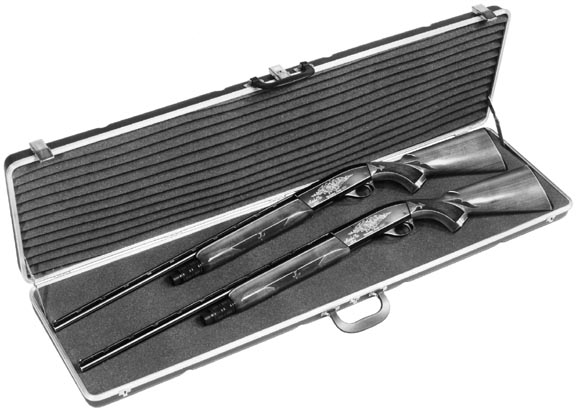
Remington Model 1100 Matched Pairs (.410 shotgun and a 28 guage shotgun in Field and Skeet versions first introduced in 1969)
version of the Model 1100 in 12 and 20 gauge guns in Field Grade 12 gauge (with 30″ full choke, 28″ modified, and 26″ improved cylinder vent rib barrels), and 20 gauge (with 28″ full and modified, and 26″ improved cylinder vent rib barrels) , Magnum Grade 12 gauge only (with 3″ chamber and 30″ full choke, vent rib barrel) for $234.95, SA Skeet Grade 12 and 20 gauge (with 26″ vent rib skeet barrel) for $224.95, and Trap Grade 12 gauge only (available with regular trap for $259.95, or Monte Carlo style stock, and 30″ full choke, vent rib trap barrel for $269.95) variations.
1973
Remington introduced a special limited edition Model 1100 Ducks Unlimited Commemorative Shotgun, a 12 gauge chambered for 2 3/4″ shells with full choke, vent rib 30″ barrel. This shotgun was available only in 1973, and was dedicated to the Ducks Unlimited organization. The right side of the receiver was roll-stamped with a simple gold-colored scroll pattern. Centered on the left side of the receiver panel is a multi-colored bronze medallion depicting a canvasback duck, the Ducks Unlimited mallard head logo, flanked by decorative scroll work. At the lower left, stamped in gold-colored script is Remington Model-1100TM and on the lower right is the serial number preceded by DU. Six hundred of these guns were sold directly to DU Chapters for fund raising dinners in 1973, and 10,000 sold conventionally.
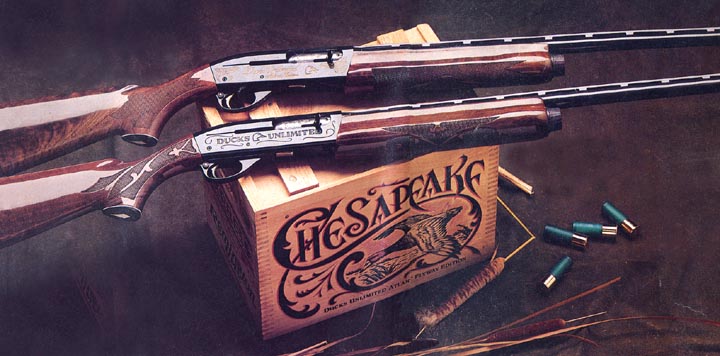
1974
Remington introduced the Model 1100 TBMC Trap Gun, in 12 gauge with 30-inch, vent rib barrel in full or modified trap chokes ($274.95). This gun featured a figured and checkered stock and fore-end, and had a rubber recoil pad. A Monte Carlo style stock was optional. A left-hand version of this gun was also available ($2 69.95). Due to a shortage of American walnut, in mid-year Remington began fitting some Model 1100 and Model 870 Field Grade shotguns with lightweight mahogany stocks and forends.
1976
In January, Remington introduced a 12 gauge Model 1100 TB Trap Gun in right and left-hand versions, with select American walnut in regular Trap or Monte Carlo style stock, rubber recoil pad, and ventilated rib. Advertising stated that this gun gives the shooter the All-Events competitive edge. Prices ranged from $314.95 to $329.95. To honor Americas Bicentennial Remington brought out four commemorative 12 gauge variations of the Model 1100: Model 1100 (28″ plain barrel with modified choke); M1100 SA Skeet Bicentennial (26″ vent rib with skeet choke for $284.95); M1100 TB Trap Bicentennial (30″ vent rib with full choke for $319.95 with standard stock and $10.00 more for Monte Carlo stock); and M1100 TBMCS Trap Bicentennial (with 30″ vent rib with full choke and Monte Carlo stock). Centered on the left side of the receiver panel is a gold-colored roll-engraved Bicentennial American Eagle and Shield with the dates 1776 and 1976 and scroll pattern. At the lower left stamped in script is Remington Model-1100 and on the lower right is the serial number. The right side of the receiver has simple scroll roll-markings in gold-color. Approximately 5,000 Bicentennial Model 1100 shotguns were sold.
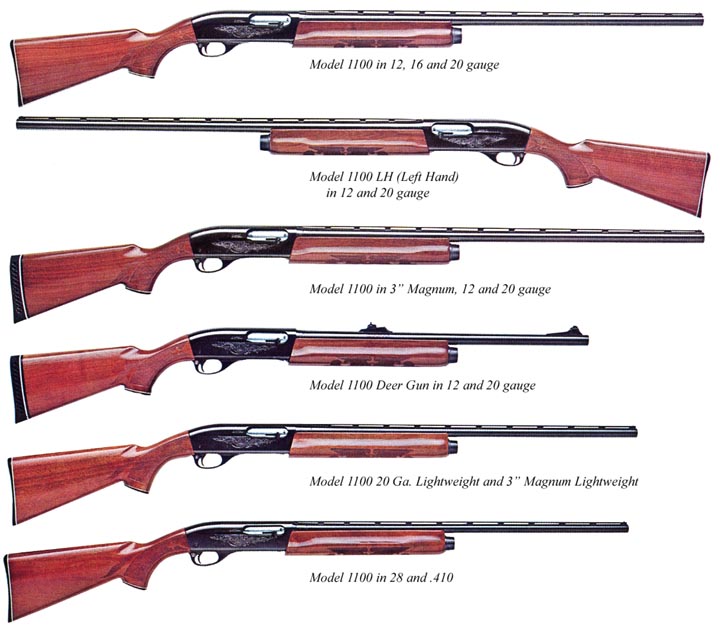
1977
In March, Remington Arms Company proudly announced the manufacture of the two-millionth Model 1100 shotgun. Also in 1977, Remington introduced a new, redesigned Model 1100 20 gauge Lightweight (called LT-20) in Field Grade, Magnum and Skeet versions. These guns are visually distinguishable from previous 20 gauge models by the contoured ejection port (long barrel extension).
1978
The Model 1100 LT-20 (20 gauge) is available in a Field Grade version. Formerly, this gun was built on a larger 12 gauge frame. Concurrently, the Model 1100 20 gauge left-hand version was dropped, and was not available in LT-20 versions. The new Model 1100 LT-20 Deer gun replaced the older, large receiver 20 gauge Deer g un. The new gun had a 20″, improved cylinder barrel with rifle sights. Stocks on all Model 1100 LT-20 Field guns now were being made of walnut instead of mahogany.
1979
In this year, Remington introduced a new stock “cut checkering” pattern and receiver scroll marking on all Model 1100 Field, Magnum, Skeet and Trap models. Model 1100 12 gauge 3″ magnum shotguns were adapted to function with extra barrels chambered for 2 shells. Also in 1979, Remington introduced Model 1100 Tournament Grade Trap guns with 30″ full or modified trap barrels; and new Model 1100 Tournament Skeet guns in 12, LT-10, 28 and 410 gauge versions. New guns featured select walnut stocks with the new cut-checkering pattern. Remington also introduced Model 1100 TA Trap 1976 Remington Company Catalog guns with regular grade stocks, as distinguished from Tournament Grade Trap guns , are introduced in both left and righthand versions. Model 1100 TB Trap guns were discontinued in this year.
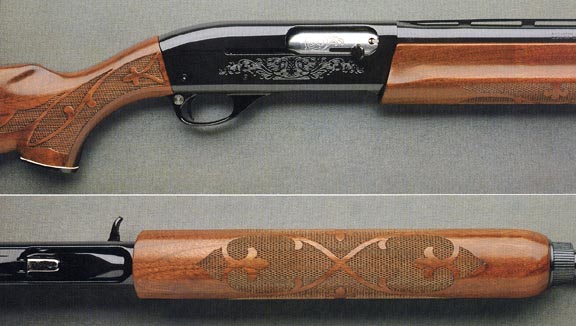
A new scroll stamping on the receiver and cut-checkering patterns on the stock and forend were placed on Model 1100 receivers in 1979.
1980
Remington introduced the Model 1100 LT-20 “Limited”, a 20 gauge lightweight Mode l 1100 Field gun with stock 1- inches shorter than standard, and 23″ barrel for youthful, beginner shooters of smaller stature. This year Remington also introduced special Skeet weight-equalizer kits for Model 1100 410 bore, 28 gauge and LT 20 Skeet guns. The weightequalizer kits were intended to give the three smaller gauge Model 1100s nearly identical balance and point-ability of the larger and heavier 12 gauge version. In September 1980, Remington announced the Model 1100 Limited Edition “One of Three Thousand.” This was a high grade gun with positive cut checkered fancy American walnut wood with a fitted rosewood grip cap and thin brown butt pad. It is 14K gold trimmed and etched with a hunting scenes on the receiver. All metal parts including the receiver, barrel, bolt and magazine cap have a high-luster finish. This limited edition gun was available only in 1980, and was produced only in 12 gauge with a 28″, modified choke, vent rib barrel. Serial numbers went from LE-80-0001 to LE-80-3000, and this custom gun retailed for $1125.00.
1981
Remington introduced the first of two Model 1100 Ducks Unlimited Commemorative guns in limited editions of 2,400 each, sequentially serial numbered with special markings. These guns were called “dinner guns” and were intended to be sold orauctioned-off only by Ducks Unlimited. Guns in this DU series were all “Atlantic Editions” which commemorated each of the countrys flyways. The first was “The Chesapeake”, a 12 gauge magnum with full choke, vent rib 30″ barrel. It featured select, high-grade and checkered wood, gold-colored trigger, ivory bead front sight, and supplied with a foam-lined hard cover carrying case. The right side of the receiver was stamped with DUCKS UNLIMITED ATLANTIC EDITION and the Ducks Unlimited mallard head symbol. The left side of the receiver is stamped THE CHESAPEAKE, surrounded by simple scroll markings, and centered in the panel is a bronze medallion depicting a canvasback duck. The second Ducks Unlimited gun this year was called the “Ducks Unlimited Special”, a Model 1100 LT-20, a lightweight 20 gauge with a 26″ improved cylinder, vent rib barrel and 2 chamber. The right side of the receiver has the Ducks Unlimited mallard head logo flanked by decorative scroll work. The left side of the receiver is stamped DUCKS UNLIMITED SPECIAL. The right side of the butt stock was laser-etched with a reproduction of the DU crest. Remington also announced a limited production run of Model 1100 12 gauge magnum guns with 26″ full choke, vent rib barrels and 3″ chambers.
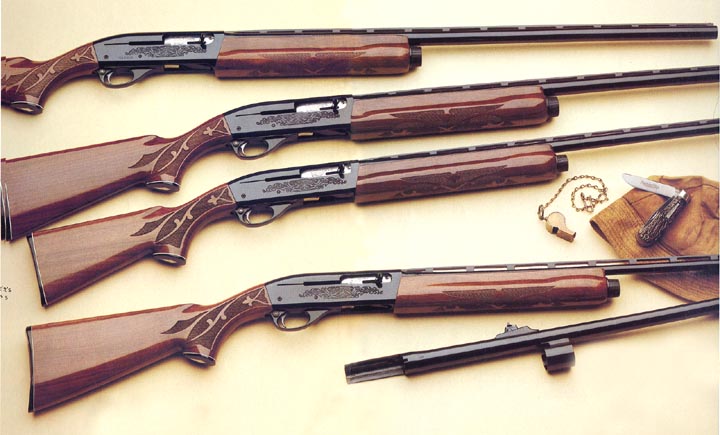
1982
Remington introduced a left-hand, 12 gauge Model 1100 Deer gun. Also added to the line was a 28″ modified barrel for the Model 1100 LT-20 (20 gauge Lightweight) Magnum produced in 12 gauge Skeet version. Remington also introduced a Ducks Unlimited Commemorative Model 1100 this year which was available to all shooters through the standard dealer network. It was a 12 gauge magnum chambered for 3″ shells with full choke, ventrib 32″ barrel. This shotgun was available only in 1982, and was titled “The Atlantic”, dedicated to the Atlantic Flyway. The right side of the receiver was stamped with DUCKS UNLIMITED and the Ducks Unlimited mallard head symbol. The left sideof the receiver is stamped THE ATLANTIC, surrounded by simple scroll markings.
1983
Remington announced that the company had manufactured its three-millionth Model1100 autoloading shotgun. Also in 1983, Remington introduced the new Model 1100 “Special Field” shotgun in 12 and 20 gauges with a checkered straightgrip, English-style stock and 21″ vent rib barrels in three field chokes.
1984
The Model 1100 LT-20 Limited name was changed to Model 1100 LT-20 Youth Gun with a change of the barrel length to 21″.
1985
Remington introduced the new Model 1100 SP “Special Purpose” Magnum Shotgun with a low luster finish to the hardwood stock and fore-end and a sandblasted, dull blued finish on all exposed metal parts. This gun has a 3″ chamber and a 26″, full choke vent rib barrel or 30″ full choke barrel. A standard feature was a camouflaged nylon sling and sling swivels. This gun was touted as being “a great choice for turkey hunting in heavy cover, or for fast handling in a blind.”
1986
Remington introduced the new RemChoke system which thereafter was fitted on allModel 1100 and Model 870 shotguns with 21″, 26″ and 28″ barrels. It was not available on 30″ barrels, deer guns, target guns or as a retrofit. This patented device allows the shooter to use a wrench to change the shotgun to full, modified or improved cylinder chokes.
1987
RemChokes were now made in 20 gauge, as well as the original 12 gauge.
1989
Remington advertised that all Model 1100 autoloading shotguns featured stocks and forends carved from American walnut and satin-finished and custom checkered. All vent rib barrels featured an ivorybead front and metal bead mid-sight. Also, every 20 gauge Model 1100 came equipped with RemChoke tubes (except Deer guns which have a fixed choke).
1991
This year marked Remingtons 175th year in the gun making field. Remington changed the Model 1100 LT-20 Youth Gun designation to Model 1100 Youth Gun. This was a 20 gauge gun designed specifically for younger and small-framed shooters. A 21″ barrel with RemChoke tubes was standard.
1994
Remington introduced a 20 gauge Model 1100 with fully-rifled cantilever deer barrel, intended for “long range deer hunting”. The “cantilever” referred to was the cantilever scope mount, “a rigid platform that wont lose zero, even after the effects of repeated slug recoil.” This shotgun featured a 21-inch, fully rifled slug barrel and cost $652.00. The Model 1100 Special Field shotgun now featured a 23″ ventilated rib barrel with RemChoke, a slimmed and shortened fore-end, and cost $605.00.
1996
Remington reintroduced the Model 1100 LT-20 Skeet Gun. This 20 gauge shotgun featured a satin-finished American walnut stock with sharp-line checkering, and a 26″ vent rib barrel with RemChoke. The Model 1100 Synthetic was first offered with a synthetic stock and fore-end in 1996, in both 12 gauge (with 28″barrel) and 20 gauge (26″ barrel) versions. A ventilated rib barrel with RemChoke was standard, and either version cost $492.00. Remington also introduced the Model 1100 Sporting 28, a 28 gauge shotgun for Sporting Clays competition. It featured a checkered American walnut, tournamentgrade stock and fore-end, rubber recoil pad and 25″ vent rib barrel with four RemChoke tubes. This gun retailed for $748.00.

Remington Model 1100 Synthetic Shotgun
1997
Remington introduced the Model 1100 LT-20 Synthetic FR RS, a 20 gauge, rifle-sighted deer gun with a 21″ fully-rifled barrel. It sold for $475.00. Concurrently, Remington introduced the Model 1100 Synthetic FR / CL, a 12 gauge, fully-rifled, cantilever deer gun costing $585.00.

Remington Model 1100 LT-20 Synthetic FR RS Shotgun

Remington Model 1100 Synthetic FR / CL Shotgun
1998
Remington introduced a Model 1100 Sporting 20, intended for shooters who preferred a lightweight, low-recoil 20 gauge autoloader in 12 gauge skeet events. This gun sports a gloss-finish, checkered,tournament grade American walnut stock and forend, recoil pad, and a 28″ vent rib barrel with RemChoke tubes. It retailed for $781.00.
1999
Remington introduced the Model 1100 Youth Synthetic Turkey Camo shotgun, featuring 20 ga. Magnum, 21″ vent rib barrel, twin-bead sights, 40 overall, RealTree Advantage Camo pattern synthetic stock and weight of 6 lbs. The company also introduced the Model 1100 Youth Synthetic LT-20 shotgun, a 20 gauge gun with 21″ vent rib barrel, overall length of 40 , 6 lbs., and a matte-finished, black synthetic stock.

Remington Model 1100 Youth Synthetic Turkey Camo Shotgun
2000
Remington introduced the Model 1100 Sporting 12 shotgun, in 12 gauge with 28″ vent rib barrel, twin bead sights, high polished blue finish, 49″ overall, semi-fancy American walnut high-gloss stock and weight of 8 lbs. In this year, Remington also introduced the Model 1100 Classic Trap shotgun, in 12 gauge with 30″ vent rib barrel, twin bead sights, high polished blue finish, 50 overall, semi-fancy American walnut high-gloss stock and weight of 8 lbs, 4 oz.

Remington Model 1100 Sporting 12 Shotgun Remington

Model 1100 Classic Trap Shotgun
2003
Remington introduced the Model 1100 LT-20 Youth Synthetic Turkey Camo, a 29 ga.magnum with 21″ vent rib barrel, twin bead sights, non-reflective, matte-black receiver finish, 40 overall length, synthetic, camo-covered stock and weight of 6lbs, 8oz. The company also introduced the Model 1100 Tournament Skeet shotgun, featuring 12 ga. 26″ vent rib barrel, twin bead sights, high polished blued receiver, 47″ overall, semi-fancy, high gloss American walnut stock and 8 lb weight. Remington also introduced the Model 1100 16 Gauge Classic Field shotgun with American walnut stock with machine cut-checkering, a polished, plain-sided receiver roll-marked with Classic Field, 26″ or 28″ vent rib barrel, twin bead sights, 46″ or 48″ overall, semi-fancy, satin-finished American walnut stock and 7 lb or 7lb, 4oz weight.

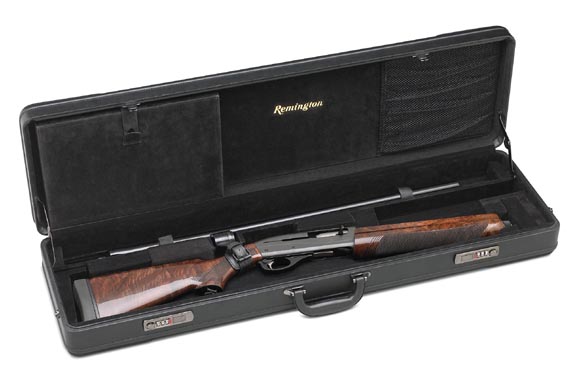
Remington Model 1100 G3 Shotgun
2006
Remington introduced the Model 1100 Competition shotgun which featured 12 ga. optimized for 2 target and light field loads, 30″ overbored barrel, target style rib with steel midbead and ivory front bead, new Pro-Bore choke tube, semifancy, high gloss American walnut stock, standard and adjustable comb, Remington R3 recoil pad, 50 overall, and 8 lb weight. The company also introduced the Model 1100 Classic Field shotgun in 12 ga., 28 ga., and .410., and the Model 1100 Tactical shotgun, featuring an olive drab barrel and receiver, and a 4-shot magazine extention.

Remington Model 1100 Competition Shotgun with adjustable comb

Remington Model 1100 Tactical Shotgun
The Remington Model 1100 is truly a shooters shotgun, either on the trap, skeetor sporting clay range, and in the field or duck blind.
Dating Your Model 1100 Shotgun
One way to date your Model 1100 shotgun is to locate the code on the left side of the barrel, just forward of the receiver. The first letter indicates the month of production, and the second letter indicates the year of production. By wary, though, as many guns have replacement barrels. [See the 2005 edition number 26,of the Blue Book of Gun Values, page 1,893. ]
Model 1100 serial numbers (on the receiver) started with the number 1001. All but the early guns also have a prefix letter. All Model 1100 Remington shotguns were serial numbered in blocks of numbers. Each serial number has a suffix and the following indicates the meaning:
| V = 12ga. standard | 2″ frame/receiver |
| M = 12ga. magnum | 3″ frame/receiver |
| W= 16ga. | 2″ frame/receiver |
| X = 20 ga. | 2″ frame/receiver |
| N = 20 ga. magnum | 3″ frame/receiver |
| K = 20 ga. lightweight | 2″ frame/receiver (LW) |
| K = 20 ga. lightweight | 2″ frame/receiver (LT) |
| U = 20 ga. lightweight magnum | 3″ frame/receiver |
| J = 28ga. | 2″ frame/receiver |
| H = .410 | 3″ frame/receiver |
In my opinion, the Model 1100 is the best autoloading shotgun ever produced. Ithas light recoil, it points better than any other shotgun I know, and if it is well maintained, it remain trouble free. I shot a Model 1100 Trap B, for sixteen years and only switched to the Model 1187, when the Model 1100 trap guns were discontinued in 1987. I still use a 1971 vintage 20 gauge Model 1100 LW in the field, with an improved cylinder choke. True, some of the finish has worn off the wood and the receiver. It may not look as good as it once did, but it sure points and shootswell enough for me to bag my limit time after time. The Remington Model 1100 is one fine gun.
| On-line Search/Sort Journal Index |
On-line Journal Articles New Journals have links to
|


